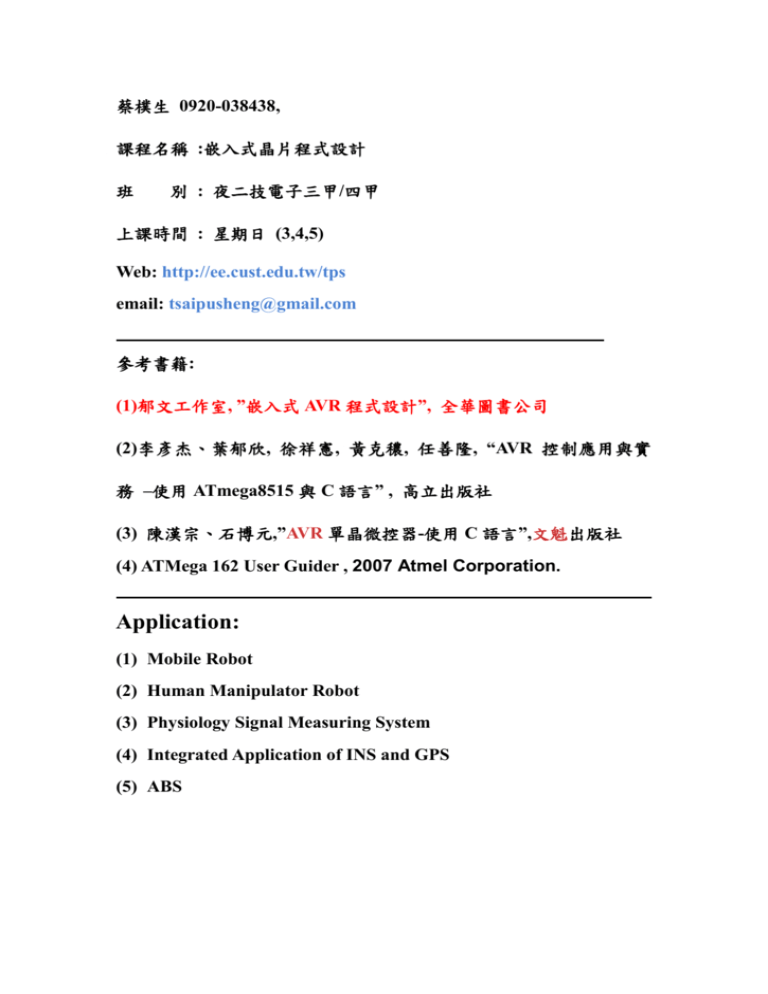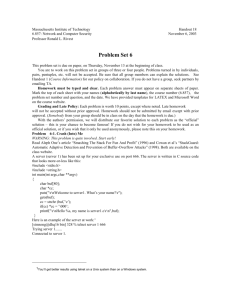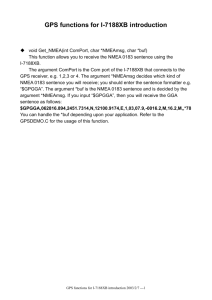CH 1 ATMega168晶片特性分析
advertisement

蔡樸生 0920-038438,
課程名稱 :嵌入式晶片程式設計
班
別 : 夜二技電子三甲/四甲
上課時間 : 星期日 (3,4,5)
Web: http://ee.cust.edu.tw/tps
email: tsaipusheng@gmail.com
參考書籍:
(1)郁文工作室, ”嵌入式 AVR 程式設計”, 全華圖書公司
(2)李彥杰、葉郁欣, 徐祥憲, 黃克穠, 任善隆, “AVR 控制應用與實
務 –使用 ATmega8515 與 C 語言” , 高立出版社
(3) 陳漢宗、石博元,”AVR 單晶微控器-使用 C 語言”,文魁出版社
(4) ATMega 162 User Guider , 2007 Atmel Corporation.
Application:
(1) Mobile Robot
(2) Human Manipulator Robot
(3) Physiology Signal Measuring System
(4) Integrated Application of INS and GPS
(5) ABS
Chapter I ATMega168 晶片特性
CHINA UNIVERSITY OF SCIENCE AND TECHNOLOGY
DEPARTMENT OF ELECTRONIC ENGINEERING
EDITED BY ASSOCIATED PROFESSOR PU-SHENG TSAI
Features
• High-performance,
Low-power AVR® 8-bit Microcontroller
4 : nibble, 8: byte, 16 : word 32:dword
8 bit: width of bus
32 bit : speed 最快, 耗電最高
4bit : speed 最慢, 最省電
1. 嵌入式微控制器 Embedded MicroController Unit (EMCU)
89S51, ATMega162, PIC18F4520
2. 嵌入式微處理器 Embedded MicroProcessor Unit (EMPU)
ARM9, ARM10
3. 嵌入式 DSP 處理器 Embedded Digital Signal Processor (EDSP)
TMS32C5X, TMS32C6X
4. 嵌入式晶片上系統 Embedded System on Chip (ESOC)
Nios, Psoc
• Advanced RISC Architecture
RISC : Reduced Instruction Set Computing 精簡指令集
1. 指令很少 : 131
2. 每一個指令佔一個記憶體的單位(2 byte)
3. 每一個指令執行時間只佔一個機械週期 (machine cycle)
CISC: Complex Instruction Set Computing 複雜指令集
Since all AVR instructions are 16 or 32 bits wide,
ex 1: By using AVR studio to prove the AVR chip is RISC
…..
每一個機械週期
[Case I] AVR Chip (RISC)
Using 12 MHz osc., machine cycle = 1/ 12 us
rjmp here : 佔 1/6 us
[Case II] 89S51
Using 12MHz osc.
每一個振盪週期所佔時間: 1/12 us
每一個狀態週期所佔時間: 1/6 us
每一個機械週期所佔時間: 1us
nop (1us),
MUL , DIV (4us)
AVR 執行速度為 89S51 快 12 倍以上。
;============================================================
;BASIC_1:
MEMORY ACCESS (SRAM WRITE)
;
Prove that ATMega162 is RISC
;2012/09/13
;============================================================
.include "m162def.inc"
.include "basic.inc"
.cseg
.org
0
rjmp
start
;============================================================
;main program
;============================================================
start:
;(1)Set Stack Pointer(SP)堆疊指標
ldi
out
ldi
buf_1,low(RAMEND)
SPL,buf_1
buf_1,high(RAMEND)
out
SPH,buf_1
;(2)Set I/O PORT MODE 輸出/輸入模式
;
PORTC : OUTPUT
ldi
buf_1,$ff
out
DDRC,buf_1
out
PORTC,buf_1
ldi
r27,$01
;X = $0100 index register
ldi
ldi
ldi
r26,$00
buf_1,255
buf_2,$aa
;counter
;data
st
dec
brne
X+,buf_2
buf_1
L1
st
dec
X+,buf_2
buf_1
brne
L2
st
dec
brne
X+,buf_2
buf_1
L3
st
dec
brne
X+,buf_2
buf_1
L4
st
X,buf_2
L1:
L2:
L3:
L4:
here:
rjmp
here
;==============================================
;
BASIC.INC
;==============================================
.def
buf_1
=r16
.def
buf_2
=r17
.def
.def
.def
.def
.def
.def
.def
.def
buf_3
buf_4
count
index
code
cmd
data
delay_time
=r18
=r19
=r20
=r21
=r22
=r23
=r24
=r25
.equ
.equ
.equ
.equ
.equ
.equ
LCD_BUS
LCD_DDR
LCD_PIN
e
rw
rs
=PORTC
=DDRC
=PINC
=3
=2
=1
.equ
.equ
.equ
KEY_BUS
KEY_DDR
KEY_PIN
=PORTA
=DDRA
=PINA
SRAM:
– 131 Powerful Instructions – Most Single-clock Cycle Execution
– 32 x 8 General Purpose Working Registers
– X , Y , Z denoted as 索引暫存器
[指令集] 搬移指令
Immediate data
(x)
ldi
( x ) ldi
(O)
(O)
(O)
(O)
(x)
(x)
(x)
(x)
Register ldi
rd, K($K)(0b001.)
r3,48
ldi
r16,#48
rd (r16 ~ r31)
K=0 ~ 255
ldi r28,48
ldi r19,$48
ldi r19,0x48
ldi r18,0b01001000
ldi r23,256
cpi r7,$7a
andi r7,$7a
ori r7,$7a
note: cpi, andi, ori 運算子為 r16 ~ r31 與立即資料。
[指令集] 搬移指令
Register
Register
(x)
ldi
r3,48
(O)
ldi
r16,48
(O)
mov
r3,r16
MOVW
(
)
Rd, Rr
movw
mov(movw) rd, rs (byte, word)
mov
movw
rd(r0 ~ r31)
Rd+1:Rd
r4,r16
rs(r0 ~ r31)
<- Rr+1:Rr
r17 -> r5, r16 -> r4 (even)
(x
)
movw
r5,r17
– Fully Static Operation
– Up to 16 MIPS Throughput at 16 MHz
MIPS : Mega instruction / second
在 20MHz 的工作頻率下,每一個指令之執行速度可達到 50ns。
ex2 : 藉由 AVR 每個指令與時脈關係,設計 delay_01ms 與 delay_10ms 模組
利用 matlab 來解二元一次方程式求最逼近解
執行指令
指令週期
執行次數
delay_3:
ldi
buf_3,#x
1
z
delay_2:
ldi
buf_4,#y
1
xz
delay_1:
dec
buf_4
1
xyz
brne delay_1
2
2xyz
dec
1
xz
brne delay_2
2
2xz
dec
1
z
brne delay_3
2
2z
ret
1
1
buf_3
delay_time
(1+(1+(1+2)y+1+2)x+1+2)z+1
=(1+(1+y+2y+1+2)x+1+2)z+1
=(1+x+xy+2xy+x+2x+1+2)z+1
=(4 + 4x +3xy) z +1
* (4+4x+3xy) *
(1) delay 0.1ms
1
×(3xy+4x+4)=0.0001
11059620
3xy+4x+4 1104
[(3y+4)x+4] 1104
Taking the value of x=5,y=72
(2) delay 10ms
1
×(3xy+4x+4)=0.01
11059620
110596=3xy+4x+4
[(3y+4)x+4] 110596 110604
Taking the value of x=200,y=183
AVR 速度比 MCS_51 快 12 倍以上
藉由 AVR 每個指令與時脈關係,設計 delay_01ms 與 delay_10ms 模組
利用 matlab 來解二元一次方程式求最逼近解
3xy + 4x +4 = 110596.2
y= (110596.2 – 4x – 4)/3x
0<x<255,
0<y<255
clear all;close all;
for k=1:255
x(k)=k;
t(k)=k;
y(k)=fix((110592.2-4*x(k))/ (3*x(k)));
e(k)=abs(110592.2-3*x(k)*y(k)-4*x(k));
end
x=184, y=199 (10ms)
[case I] : 延遲 1 秒鐘
ldi
delay_10ms : 10ms
delay_time,100
rcall delay_10ms
~2.55s
[case II]: 延遲 20ms 時間
ldi
delay_01ms: 0.1ms ~ 25.5ms
delay_time,2
rcall delay_10ms
l
ldi
delay_time,200
rcall delay_01ms
Problem:
(3xy+4x+4) * (1/11.05962*106)=0.0001
(3xy+4x+4) = 1105.962
(3xy+4x)=1101.962
(1)
(1101.962-4x)/3x
Optimal Solution: x = 3, y = 121, or x =20 , y=17
for delay 0.1ms
(3xy+4x+4) * (1/11.05962*106)=0.01
(3xy+4x+4)=110596.2
3xy + 4x =110592.2
(2)
Optimal Solution: x = 172, y = 213, for delay 10ms
On-chip 2-cycle Multiplier
• High Endurance Non-volatile Memory segments
– 16K Bytes of In-System Self-programmable Flash program memory
Flash ROM : +5V, small current(mA) 可以作程式燒錄(ISP)
–
In System Programming(ISP)
Batch File : 燒錄時間短
– On-chip 2-cycle Multiplier
• High Endurance Non-volatile Memory segments
–
16K Bytes of In-System Self-programmable Flash program memory
–
Addressing : 0000H ~3FFFH
ex2: 16K 定址由:
0000H
~
3FFFH
64K
0000H
~
FFFFH
9K
~
9K=8K+1K
$0000 ~ $1FFF (2000H)
+ $0000 ~ $03FF
$0000 ~ $23FF
ex3: The ATmega162 contains 16K bytes On-chip In-System
Reprogrammable Flash memory for program storage. Since all AVR instructions are 16 or 32 bits wide,
the Flash is organized as 8K x 16.
AVR 的程式記憶體, 每一個位址所佔之空間為
2
位元組 (Bytes),
由 studio 4.0 Memory 中觀察
example : 假定 user 寫成是用掉 16 K flash ROM, 每張 A4 紙可印 40
行, 試問共需幾張 A4 紙.
Function:
(a) 存放本文程式之 machine code.
(b) 中斷向量表,中斷服務副程式(Interrupt Service Routine, ISR)之起始位址
(c) 存放表格資料 (Table)
[example]
試比較以下 IC 之內部功能 ATMega8515, ATMega162, ATMega128,
PIC18F452, 89s51 , 試以表格方式列出記憶體, 執行速度, 內部功能
.cseg
; Reset and Interrupt Vector Area
.org
rjmp
.org
rjmp
.org
rjmp
0
start
EXT_INT1
?
TIM0_OVF
.
.
.
.
; External module include setup area (path need to be set)
.include
.include
.include
"m162def.inc"
"delay_10ms.asm" ; file path is needed to set
"scan_keyboard.asm"
.
.
.
Access Table Data Method :
[指令集] 搬移指令
ROM
lpm
lpm
Register
rd,Z (r0 ~ r31)
r0
相關操作指令
adiw
d {24, 26, 28,30}, 0 K 63
rd,K
rd 1: rd rd 1: rd K
adiw
r24,1;
ldi
ldi
lpm
lpm
lpm
adiw
str_table:
將 r25:r24 內容加 1
ZH,high(2*str_table)
ZL,low(2*str_table)
r0 = 41H
r6,Z+
r6 = 41h
r0 = 42h
ZH:ZL,1
(Z)
“ABCDabcd01234”,0xaa,0xbb,0xcc,0xdd,0xee,0xff
.db
ex4: 設計一段程式,讓七段顯示器每隔一秒由 0 數到 F,並置於 studio4.0 中
的 debug 作驗證。
[Hint]: Table Data of Seven Segment Display
seg7_table:
.db
0xC0,0xF9,0xA4,0xB0,0x99,0x92,0x82,0xF8
.db
0x80,0x90,0x88,0x83,0xC6,0xA1,0x86,0x8E
mov
Immediate data
ldi
lpm
Registe
r
in
out
I/O Register
lds
ld
st
sts
– 1K Bytes Internal SRAM
Z
XY
Memory
RAM
Memory
ROM
32 通用暫存器 r0 ~ r31 ($0000 ~ $001F)
64 I/O 暫存器 ($0020 ~ $005F) : Special Function Register
160 擴充 I/O 暫存器 ($0060 ~ $00FF)
1K 內部 SRAM 記憶体 ($0100 ~ $04FF) : 存放程式中所用到的
資料, 變數以及工作旗標.
(5) 外部擴充 SRAM 記憶体 ($0500 ~ $FFFF): 最大可擴充至 64K
(1)
(2)
(3)
(4)
[指令集] 搬移指令
Register
Memory (Direct Addressing)
lds
rd, k
sts
k, rd
lds
rd (r0 ~ r31)
k ($0000 ~ $ffff)
sts
lds
r3,$0600
(off chip memory)
lds
r3,$0200
sts
$0200, r3
.equ
ult_L
lds
r3, ult_L
sts
ult_L, r3
lds
r17,$fe00
(on chip memory)
=$0100
(off chip memory)
[指令集] 搬移指令
Register
Memory (Indirect Addressing)
ld
rd, X(Y,Z)
ld
rd, -X(Y,Z)
ld
rd, X-(Y,Z)
ld
(X), (Y), (Z)
rd (r0 ~ r25)
st
MOV A,@R0
MOV A,Rn
MOV Rn,A
MOV @R0,A
(R0, R1) 才能作間接定址
[Example]
for
ldi
ldi
ld
ld
ldi
ld
ld
ATMega8515
RAM address = $0060
r27,$00
r26,$60
r0,X+
r1,X
r26,$63
r2,X
r3,-X r0 =
66H
39H
A4 H
78H
, r1 =
, r2 =
$0060
, r3 =
ex5: 試設計 AVR162 間接定址的程式,將 SRAM 記憶体全部清除為 $AA,並
置於 studio4.0 中的 debug 作驗證。
====================================================
ldi
ldi
ldi
ldi
r27,$0101
; X= $0100 index register
r26,$0000
buf_1,25555 ;counter
buf_2,$aa$aa ;data
stst
dec
X+,buf_2 buf_2
buf_1
brne
L1
stst
dec
brne
X+,buf_2 buf_2
buf_1
L2
stst
dec
brne
X+,buf_2 buf_2
buf_1
L3
stst
dec
brne
X+,buf_2 buf_2
buf_1
L4
L1:
L2:
L3:
L4:
.
.
I/O Register :
out
in
PORTA, buf_1
buf_1, PINA
.
– 512 Bytes EEPROM
The ATmega162 contains 512 bytes of data EEPROM memory. It is organized as a separate
data space, in which single bytes can be read and written.
The access between the EEPROM and the CPU is described in the following, specifying
EEPROM Address Registers, EEPROM Data Register, and EEPROM Control Register.
• Bit 2 – EEMWE: EEPROM Master Write Enable
The EEMWE bit determines whether setting EEWE to one causes the EEPROM to be
written. When EEMWE is set, setting EEWE within four clock cycles will write data
to the EEPROM at the selected address. If EEMWE is zero, setting EEWE will have
no effect. When EEMWE has been written to one by software, hardware clears the bit
to zero after four clock cycles.
• Bit 1 – EEWE: EEPROM Write Enable
When address and data are correctly set up, the EEWE bit must be written to one to
write the value into the EEPROM.
EEPROM
WRITE
EEPROM
READ
ex6 : To verify the function of EEPROM of AVR,
$00~ $ff 資料被寫入 EEPROM $00~ $ff 位置內,斷電後依序讀出並存入
SRAM $0060 的位置內。
;========== EEPROM Access =========
Ldi
count,255
ldi
code,0
ldi
buf_1,0
;EEPROM_write:
;
;
;
;
;
;
;
;
;
;
sbic
rjmp
out
out
out
sbi
sbi
inc
dec
brne
EECR,EEWE
EEPROM_write
EEARH,buf_1
EEARL,code
EEDR,code
EECR,EEMWE
EECR,EEWE
code
count
EEPROM_write
;====================================
clr
r29
ldi
r28,$60
ldi
count,255
ldi
code,0
ldi
buf_1,0
EEPROM_read:
sbic
EECR,EEWE
rjmp
out
out
sbi
in
st
inc
dec
brne
EEPROM_read
EEARH,buf_1
EEARL,code
EECR,EERE
buf_2,EEDR
Y+,buf_2
code
count
EEPROM_read
– Write/Erase cycles: 10,000 Flash/100,000 EEPROM
– Data retention: 20 years at 85°C/100 years at 25°C(1)
– Optional Boot Code Section with Independent Lock Bits
In-System Programming by On-chip Boot Program
True Read-While-Write Operation
– Up to 64K Bytes Optional External Memory Space
– Programming Lock for Software Security
• JTAG (IEEE std. 1149.1 Compliant) Interface
– Boundary-scan Capabilities According to the JTAG Standard
– Extensive On-chip Debug Support
– Programming of Flash, EEPROM, Fuses, and Lock Bits through the JTAG Interface
• Peripheral Features
– Two 8-bit Timer/Counters with Separate Prescalers and Compare Modes
– Two 16-bit Timer/Counters with Separate Prescalers, Compare Modes, and
Capture Modes
– Real Time Counter with Separate Oscillator
– Six PWM Channels
– Dual Programmable Serial USARTs
– Master/Slave SPI Serial Interface
– Programmable Watchdog Timer with Separate On-chip Oscillator
– On-chip Analog Comparator
• Special Microcontroller Features
– Power-on Reset and Programmable Brown-out Detection
– Internal Calibrated RC Oscillator
– External and Internal Interrupt Sources
– Five Sleep Modes: Idle, Power-save, Power-down, Standby, and Extended Standby
• I/O and Packages
– 35 Programmable I/O Lines
– 40-pin PDIP, 44-lead TQFP, and 44-pad MLF
• Operating Voltages
– 1.8 - 5.5V for ATmega162V
– 2.7 - 5.5V for ATmega162
• Speed Grades
– 0 - 8 MHz for ATmega162V (see Figure 113 on page 266)
– 0 - 16 MHz for ATmega162 (see Figure 114 on page 266)






